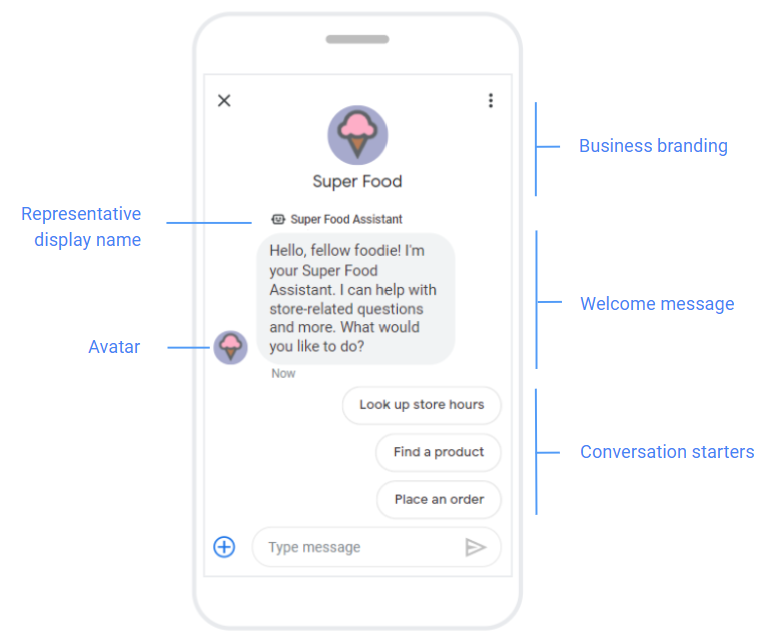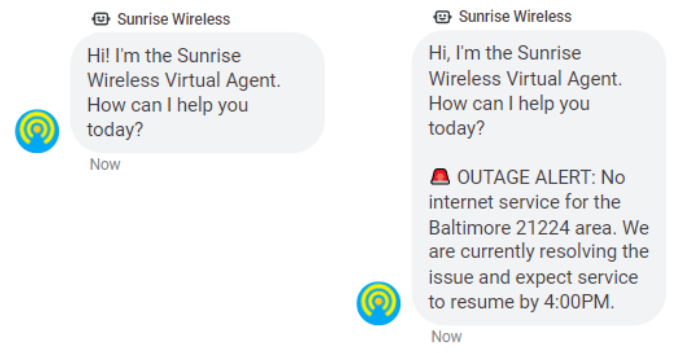ابدأ برسالة ترحيب رائعة. يجب أن تحدد الرسالة الأولى بوضوح التوقعات حول ما يمكن أن تحقّقه المحادثة. احرص على أن يكون الوصف قصيرًا ومختصرًا. يجب أن تكون رسالة الترحيب ملائمة وداعمة وأن تسهِّل على العميل التفاعل معك.
تمثيل علامتك التجارية
تتيح ميزة "الرسائل التجارية" إجراء محادثات فردية. حدِّد الأسلوب من خلال تحية العميل وتقديم علامتك التجارية. إذا أنشأت شخصية لمحادثة chatbot، مثل مساعد افتراضي أو خدمة استعلامات رقمية، يجب توضيح أنّه برنامج وليس شخصًا حقيقيًا. يمكنك تعديل الاسم المعروض للممثّل لمطابقة الشخصية.
إنّ الصورة الرمزية هي طريقة رائعة لتعزيز صورتك. يمكن أن يكون بسيطًا مثل استخدام شعارك، ولكنّ شخصية رسومية بأسلوب الرسوم المتحركة تناسبك أيضًا.

تخصيص الرسالة
استخدِم البيانات السياقية لتخصيص رسالة الترحيب. وتشمل هذه البيانات اللغة لنقطة الدخول ومعرّف المكان (لنقاط الدخول الخاصة بالموقع الجغرافي). يمكنك إنشاء رسالة ترحيب فريدة لكل لغة وموقع جغرافي للنشاط التجاري توفّر الدعم له.
يتم عادةً تمرير البيانات السياقية مع الرسالة، ولكن قد لا تكون متوفّرة. تأكَّد من أنّه يمكن للموظف العمل بدونها.
تقديم مسار واضح للمضي قدمًا
توضِّح رسالة الترحيب الجيدة ما تقدّمه المحادثة. ويشرح وظيفة الوكيل على مستوى عالٍ. ويتضمّن أيضًا مواضيع مناسبة لبدء المحادثات لتوجيه المستخدِمين إلى مسارات معيّنة. استخدِم عبارات لبدء المحادثات من أجل إثارة اهتمام المستخدم وتوجيهه إلى المهام التي يمكن لموظّف الدعم تنفيذها. للحصول على نصائح حول مواضيع جيدة لبدء المحادثات، يُرجى الاطّلاع على مقالة استخدام أسلوب المحادثة.
تعديل المحتوى باستخدام الإشعارات
قدِّم معلومات محدّثة تساعد المستخدمين في الخدمة الذاتية. إذا كان هناك عنصر أو حدث جديد تتوقع أن يبحث عنه المستخدمون، مثل انقطاع الخدمة، يمكنك تعديل رسالة الترحيب ونقاط بدء المحادثات لتضمين هذه الأخبار مؤقتًا.

